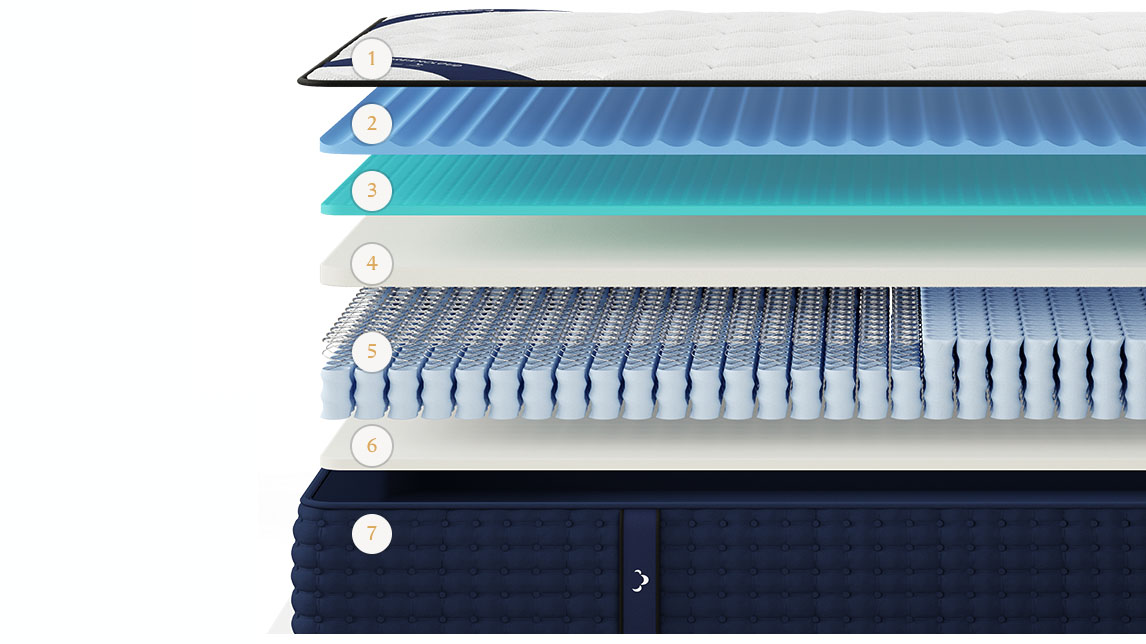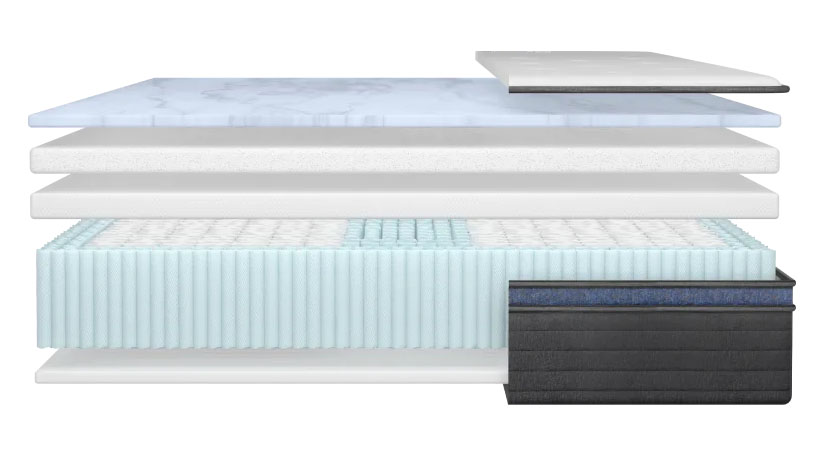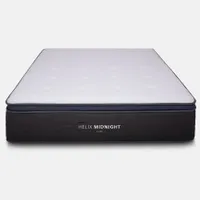DreamCloud vs Helix: Which luxury hybrid mattress is best for sleep?
It’s DreamCloud vs Helix in this luxury hybrid mattress head-to-head

The DreamCloud Hybrid and Helix Midnight Luxe are two popular hybrid mattresses that both promise a luxurious sleep experience. While on the surface they have many similarities, under the covers these mattresses are suited to very different sleepers. So, in this DreamCloud vs Helix mattress comparison piece, we will help you to decide which one is best for you and your sleep.
The DreamCloud Hybrid mattress features in both our best mattress and best hybrid mattress guides, due to its impressive build quality and comfort levels. Meanwhile, the Helix Midnight Luxe’s slightly less refined younger sibling, the Helix Midnight, is our top pick in our best mattresses for side sleepers round up. However, the Helix Midnight Luxe, which is also best suited to side sleepers, is considerably more expensive than the DreamCloud, with a queen size mattress costing over $1,000 more at full MSRP. So the question is, is the Helix Midnight Luxe worth the price hike?
We’ve rigorously tested the DreamCloud Hybrid so you can read our in-depth DreamCloud Hybrid Mattress Review for all the analysis and test data. And, although we haven’t reviewed the Helix in depth yet, we have had a chance to test it out at Helix’s factory, so you can read our shorter guide to the Helix Midnight Luxe mattress here. This head-to-head comparison will help you make an informed choice on which, if either, of these luxury hybrid mattresses is right for you. Let’s get started.
DreamCloud Hybrid: from $839 $449 at DreamCloud
Even at full MSRP, the DreamCloud Hybrid delivers a level of luxury beyond its lower to mid-range price bracket. DreamCloud currently has a 40% off sale, bringing the price of a queen down to $799 from $1,332. This is a fairly standard sale from DreamCloud, but is still excellent value.
Helix Midnight Luxe: from $1,373.80 $1,099 at Helix There’s currently a site-wide 20% off sale at Helix, which brings the price of a queen size Helix Midnight Luxe down to $1,899 from $2,373.80. We do tend to see Helix offer 25% during major sale events, but 20% off is still an excellent price for a mattress of this quality.
| Row 0 - Cell 0 | DreamCloud | Helix Midnight Luxe |
| Type: | Hybrid | Hybrid |
| Internal layers: | 5 | 6 |
| Firmness (1 -10): | 6.5 | 5-6 |
| Height: | 14" | 13.5" |
| Trial: | 365 nights | 100 nights |
| Warranty: | Lifetime | 15 years |
| MSRP: | $839 - $1,669 | $1,378.80 - $2,873.80 |
DreamCloud vs Helix: Price & warranty
- The DreamCloud is always on sale, with a queen selling for $799
- The Helix usually offers 20% off, rising to 25% at major sales events
- The DreamCloud offers a much longer sleep trial and lifetime warranty
You can ignore MSRP with the DreamCloud as there’s always a DreamCloud mattress sale on, which takes the mattress down into the low to mid-range bracket. This makes it an extremely affordable luxury hybrid, with prices being considerably lower than the Helix Midnight Luxe.
DreamCloud’s current deal has been running since April 2023 and reduces the price of a queen to $799. If you want to maximise your savings, you can also add in a bedding bundle at a highly discounted price. We have previously seen the mattress reduced to $899 with the bedding bundle included for free, so either of these deals will save you a considerable amount. DreamCloud also throws in some generous extras, such as a 365-night trial, lifetime warranty, and free shipping and returns.
Helix mattress sales also run continuously, fluctuating between 20% -25% to coincide with major sales events. You can usually expect to pick up a queen for $1,899, dropping to $1,780.40 when there’s a 25% discount. You’ll also get two free pillows thrown in but, even with the discounts, this is still a premium mattress that comes at a premium price. Helix offers a 100 night sleep trial, 10 year warranty, and free shipping, which seem a little paltry in comparison to DreamCloud’s incredible benefits.
In the unlikely event that you would ever have to pay full MSRP on either of these mattresses, let’s take a closer look at what they are.
Get instant access to breaking news, the hottest reviews, great deals and helpful tips.
| Row 0 - Cell 0 | DreamCloud | Helix Midnight Luxe |
| Twin: | $839 | $1,373.80 |
| Twin XL: | $1,089 | $1,623.80 |
| Full: | $1,199 | $1,998.80 |
| Queen: | $1,332 | $2,373.80 |
| King: | $1,669 | $2,873.80 |
| Cal king: | $1,669 | $2,373.80 |
| Split king: | $2,178 | N/A |
DreamCloud vs Helix price winner: DreamCloud
It’s impossible to ignore the enormous price difference between the two mattresses, with the DreamCloud being over $1,000 cheaper for a queen size mattress. Plus, the DreamCloud has a yearlong trial and a lifetime warranty, giving you plenty of time to try the mattress out.
DreamCloud vs Helix: Material & design
- Both mattresses are luxury hybrids
- The DreamCloud is a 14” mattress, made up of seven layers
- The Helix is a 13.5” mattress with six layers
Although both the DreamCloud and Helix are hybrids, they’re designed slightly differently. The DreamCloud starts off with a quilted cashmere blend cover, which isn’t removable for washing. Underneath is a layer of contouring foam, followed by gel memory foam for pressure relief and a transition layer to pad out the individually wrapped springs. At the base is another layer of high density foam for stability, with a non-slip cover underneath to keep the mattress in place.

The Helix comes with a quilted pillow top Tencel cover, with the option to upgrade to a GlacioTex cover for extra cooling. You’ll see this fabric in many of our best cooling mattresses, as it’s renowned for its ability to help keep sleepers cool.
Underneath the cover is a layer of polyfoam, followed by a layer of copper gel memory foam, both designed to contour to your body. Next up is a transition layer of memory foam, which sits on a layer of individually wrapped coils. These are firmer around the lumbar and edges of the mattress. Finally, there’s a dense foam base layer for support.
Both mattresses are mattresses in a box and will arrive at your front door rolled up and ready to put on your bed.

DreamCloud vs Helix design winner: It's a draw
There’s little between the designs of these two mattresses, with both of them offering plenty of padding and contouring from the foam layers, and support from the springs. We do like the ability to add in the GlacioTex cover to the Helix mattress but, of course, you will have to pay extra for this.
DreamCloud vs Helix: Comfort & support
- We rated the DreamCloud as 8/10 for firmness, which is firm
- The Helix Midnight Luxe is softer, and rated at 5-6/10 for firmness
- The Helix is designed for side sleepers vs DreamCloud's combi sleepers
Although the DreamCloud officially rates as a 6.5 out of 10 on the firmness scales, all our testers agreed that it felt more like an 8 out of 10. It does a great job of alleviating back pain and is firm enough to support both back and stomach sleepers, keeping their spines aligned and hips in the correct position.
The mattress also adapts quickly around the lower lumbar region, offering great support and pressure relief. Side sleepers may find the mattress a little firm to begin with, but after a few days the ample cushioning around the shoulders and hips will start to soften slightly and contour where needed. Some lightweight side sleepers may find it a little too firm though, particularly if they’re looking for a bed that they sink into.
The Helix Midnight Luxe is specifically designed for side sleepers, with the upper memory foam layer providing plenty of deep pressure relief around the hips and shoulders. The addition of the pillowtop on the Luxe version means that this is a softer mattress, with more squishiness than the original Helix Midnight.
There’s a classic memory foam ‘hug’ with the Helix, which also helps to make this bed exceptionally good at isolating motion and makes it a great choice for those sharing their bed with a restless partner. But there’s not quite enough support for back or stomach sleepers, although Helix do offer a range of other models that are specifically designed to cover all sleeping styles.
DreamCloud vs Helix comfort & support winner: DreamCloud
The DreamCloud is the winner here as it suits most sleeping styles and body types. However, if you sleep predominantly on your side, you should go for the Helix Midnight Luxe as it’s completely designed specifically with you in mind.
DreamCloud vs Helix: Temperature control
- Both mattresses boast cooling tech features
- None of our testers felt hot sleeping on the DreamCloud
- The Helix has the option to upgrade to a GlacioTex Cooling cover
The DreamCloud mattress scored highly when it came to temperature regulation, with even our hottest sleepers finding it surprisingly good at keeping them cool at night. There is some cooling tech in the DreamCloud in the form of a gel-infused layer designed to help dissipate body heat, along with a breathable cashmere cover and well-spaced coils to promote airflow. Although it’s not a cooling mattress, the DreamCloud did a good job of preventing overheating.
The Helix also has a breathable cover, copper gel memory foam to draw heat away from the body and individually wrapped coils to promote airflow. If you choose to upgrade to the GlacioTex cover you’re essentially making it into a cooling mattress, although the cover does make the bed quite slippery. However, without the cooling cover some customers reported that it sleeps a little warm.
DreamCloud vs Helix temperature regulation winner: DreamCloud
Unless you’re prepared to invest in the GlacioTex cover for the Helix, the DreamCloud does a better job of keeping sleepers cool at night. This was born out by the fact that even our hottest sleepers felt cool on the DreamCloud overnight.
DreamCloud vs Helix: Which should I buy?
Buy the DreamCloud if...
✅ You suffer with back pain: The DreamCloud offers fantastic pressure relief and support around the lower lumbar region, with sleepers reporting a real improvement in aches and pains.
✅ You’re of a heavier build: The firmer support of the DreamCloud means that heavier sleepers should still feel supported by the mattress, with no danger of sinking through the foams and sleeping on the coils.
✅ You’re on a tighter budget: Although the DreamCloud isn’t a cheap mattress, it’s an absolute bargain for a luxury hybrid once the discounts are applied.
Buy the Helix if...
✅ You’re a side sleeper: The memory foam upper layer on the Helix allows sleepers’ shoulders and hips to sink gently into the mattress, providing pressure relief an enough comfort for a restful night’s sleep for side sleepers.
✅ You share a bed: The memory foam layer in the Helix Midnight also means that motion isolation is excellent. You won’t be disturbed by a restless partner moving about.
✅ You want a luxurious feeling mattress: The pillowtop of the Helix gives the mattress a real touch of luxury, with a plush and squishy feel. It’s also thicker than the original model.

Jo Plumridge is an experienced mattress reviewer with several years' experience covering all things mattresses and sleep, and who tests memory foam, hybrid and organic mattresses. What Jo doesn't know about a boxed mattress isn't worth knowing, so naturally we tasked her with producing a series of features for Tom's Guide looking at all aspects of mattresses, from how to pick between latex and memory foam (it's a tricky one), to the seven mistakes people make when buying a mattress for the first time. When testing the DreamCloud Luxury Hybrid for Tom's Guide, Jo said: "I loved the back support and pressure relief it offered. Plus, it looks far more expensive than it is." When she isn’t writing about sleep, Jo also writes extensively on interior design, home products and photography.
- Nicola AppletonSleep Editor


